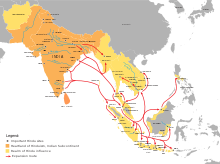
Indian honorifics are honorific titles or appendices to names used in the Indian subcontinent, covering formal and informal social, commercial, and religious relationships. These may take the form of prefixes, suffixes or replacements.
Native honorifics
Honorifics with native/indigenous Hindu-Buddhist origin.
Hindu-Sikh honorifics
List of titles
- Abhyasi
- Acharya
- Aasaan
- Ayya
- Baba
- Babu
- Bhagavan
- Bhagat
- Bhai
- Chhatrapati
- Chakravarti, Chakraborty
- Chettiar, suffix denoting a man's wealth
- Chitnis one of the most important and highest-ranking ministers in a court.
- Choudhury
- Chempakaraman
- Das, a common surname on the Indian subcontinent which has also been applied as a title, signifying "devotee" or "votary" (in the context of religion); also, Dasa[1]
- Devi
- Deshmukh, Maratha title given to "Head of State".
- Dvija
- Gain or Gayen
- Goaysain
- Guru
- JagadRayuru
- Jagirdar
- Kothari
- Kshatriya Kulavantas, Maratha title given to "Kshatriya Family".
- Kumari
- Kunwar, Kumar
- Mahamandaleshwar
- Mahant
- Maharaj, Maharaja, Maharajadhiraj
- Mahātmā
- Maharani
- Maharishi, Maharshi
- Mahayogi, Mahayogini
- Mankari[2]
- Mantrik
- Melshanthi
- Menon
- Muni
- Naidu
- Naicker
- Nayak
- Pandit
- Patil, Maratha title given to "Head of Village" & "Kshatriya Noble Family".
- Patlin, Maratha Title given to "Wife of Patil Saheb & Kshatrani".
- Paramahamsa
- Paramguru
- Potdar
- Prabhu
- Pujari
- Raj
- Raje, Raidu, Raja, Rai/Ray, Rana, Rao, Rawal, Rawat
- Rajarshi
- Rajguru
- Rajkumar, Maharajkumar
- Rajkumari, Maharajkumari
- Rani
- Reddy
- Rishi
- Rishi Mudgal
- Sādhaka
- Sadhu
- Sain Saeen
- Samanta
- Samrat
- Sannyasin
- Sardar
- Sarpatil
- Satguru, Sadguru
- Sawai
- Singh
- Sethi, Sheth, suffixes denoting a man's wealth
- Shankaracharya
- Shaunaka
- Shishya
- Sri Shri, Shree
- Shrimati, Maratha title given to "Rich or Noble Person".
- Swami
- Thakur
- Thiru or Thirumathi
- Yogi, Yogini
- Yuvraj
- Veer
Secular profession-specific honorifics
- Lambardar
- Patwari
- Pandit
- Zamindar
- Ghatwal
- Mulraiyat
- Pradhan
- Jagirdar
- Mustajir
- Zaildar
- Talukdar
- Thikadars
Influence on other cultures

With the expansion of Indosphere cultural influence of Greater India,[3] through transmission of Hinduism in Southeast Asia[4][5][6] and the Silk Road transmission of Buddhism[7][8] leading to Indianization of Southeast Asia with non-Indian southeast Asian native Indianized kingdoms[9] adopting Sanskritization[10] of their languages and titles as well as ongoing historic expansion of Indian diaspora has resulted in many overseas places having Indianised names (e.g. Sanskritised naming of people, Sanskritised naming of places, Sankritised institutional mottos, Sanskritised educational institute names), architecture, martial arts, music and dance, clothing, and cuisine.[11]
Please help expand the following partial list of Indian influenced honorifics:
- Burmese honorifics and Burmese Buddhist titles
- Cambodia honorifics
- Cham honorifics
- Filipino styles and honorifics
- Indonesian honorifics
- Khmer honorifics
- Lao honorifics
- Malay styles and titles
- Sinhala honorifics
- Thai royal ranks and titles
Maratha honorifics
Associated with the Maratha Kingdom or general Marathi-speaking population.
Sikh honorific
Nepali (Gorkhali) honorifics
Associated with the Khas Kings of Nepal, esp. the Shah dynasty of the Kingdom of Gorkha.
- Kaji
- Mukthiyar
- Jangi Lat
- Khazanchi
- Maharajdhiraj
- Maharathi
- Nayab
- Rajpratinidhi
Middle East honorifics
See also
- Honorary titles of Indian leaders
- Currently official honors:
- Past or unofficial honors:
References
- ^ Talbot, Cynthia (2001). Precolonial India in practice: Society, region, and identity in medieval Andhra. Oxford: Oxford University Press. p. 81. ISBN 0-19-513661-6.
- ^ T.N. Madan (1982). Way of Life: King, Householder, Renouncer: Essays in Honour of Louis Dumont (1st ed.). Institute of Economic Growth. p. 129. ISBN 81-208-0527-5.
- ^ Kenneth R. Hal (1985). Maritime Trade and State Development in Early Southeast Asia. University of Hawaii Press. p. 63. ISBN 978-0-8248-0843-3.
- ^ Guy, John (2014). Lost Kingdoms: Hindu-Buddhist Sculpture of Early Southeast Asia, Metropolitan museum, New York: exhibition catalogues. Metropolitan Museum of Art. ISBN 9781588395245.
- ^ "The spread of Hinduism in Southeast Asia and the Pacific". Britannica.
- ^ History of Ancient India Kapur, Kamlesh
- ^ Fussman, Gérard (2008–2009). "History of India and Greater India". La Lettre du Collège de France (4): 24–25. doi:10.4000/lettre-cdf.756. Retrieved 20 December 2016.
- ^ Coedès, George (1968). Walter F. Vella (ed.). The Indianized States of Southeast Asia. trans.Susan Brown Cowing. University of Hawaii Press. ISBN 978-0-8248-0368-1.
- ^ Manguin, Pierre-Yves (2002), "From Funan to Sriwijaya: Cultural continuities and discontinuities in the Early Historical maritime states of Southeast Asia", 25 tahun kerjasama Pusat Penelitian Arkeologi dan Ecole française d'Extrême-Orient, Jakarta: Pusat Penelitian Arkeologi / EFEO, pp. 59–82
- ^ Lavy, Paul (2003), "As in Heaven, So on Earth: The Politics of Visnu Siva and Harihara Images in Preangkorian Khmer Civilisation", Journal of Southeast Asian Studies, 34 (1): 21–39, doi:10.1017/S002246340300002X, S2CID 154819912, retrieved 23 December 2015
- ^ Kulke, Hermann (2004). A history of India. Rothermund, Dietmar, 1933– (4th ed.). New York: Routledge. ISBN 0203391268. OCLC 57054139.
External links
 Media related to Indian honorifics at Wikimedia Commons
Media related to Indian honorifics at Wikimedia Commons
